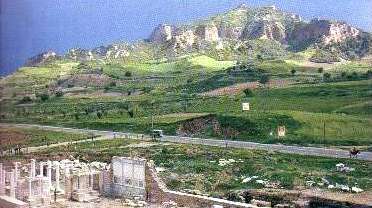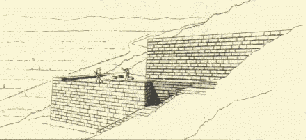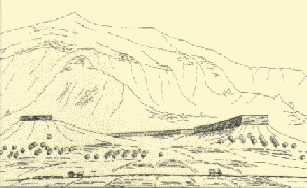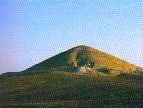|
Our knowledge of the Lydians, until the Sardis expedition directed by Howard Crosby Butler of Princeton University between 1910 and 1914, was almost entirely restricted to the literary evidence. Butler's excavations revealed over 1,100 rock-cut Lydian graves in the cemetery area known as Pactolos West, to the west of the monumental Temple of Artemis. Virtually all of the tombs were found to have been robbed in antiquity, but the finds of the expedition provided a tantalizing preview of what was to be uncovered in later years. In 1938 the American Exploration of Sardis (the Harvard-Cornell expedition), was formed, and for the past 37 years
|

Sardis and 300 m.-high citadel, looking southeast. The low artificial hill near the road is created by the ruins of the 20m.-thick fortification wall of the lower city.
|
|
Sardis has been under annual excavation and research, first under George M. A.Hanfmann of Harvard University, and more recently under Crawford H. Greenewalt, Jr., of the University of California at Berkeley.
|

Sardis, terraces of the 6th century BC on the summit of the Acropolis.
|
The citadel of Sardis had monumental buildings of ashlar masonry on terraces protected by fortification walls. With its high cliffs it was a natural stronghold watching over the lower city to its north and dominating the plain of the Hermos and the road through the valley The excellent masonry of the ashlar walls of the citadel and the terraces connected by stairs quite possibly provided some of the inspiration for Achaemenid monumental building in Iran.
|
|
Although we can gauge the splendour and monumentality of the palaces of the Lydian kings on the citadel and read about their history in Greek and Assyrian texts, the archaeological inventory of the palatial headquarters, however, is either lost or still to be discovered by new efforts and a dose of good luck.
|
The lower city was separately fortified and had its own official and civic buildings on terraces, as well as residential districts, commercial structures, industrial quarters and workshops, including a glass working atelier, and an area where there is evidence for the working of rock crystal.
Excavation of an industrial quarter near the Pactolos stream has uncovered a variety of artifacts, including a blow pipe nozzle, as well as more massive bellows, nozzles, ovens, make-shift crucibles, cupels and waste material, which attest the separation of placer electrum into gold and silver by cementation and cuppelation processes. The discovery of stone moulds supports the evidence from other sources which testifies to the Sardians' utilization of their local supplies of gold for the making of jewellery.
|

Sardis, terraces of the 7th and 6th centuries BC on lower north slopes of the Acropolis.
|

Sardis, Lydian terrace wall on
a lower spur of the citadel;
view looking southwest.
|
There is also archaeological evidence which points to the involvement of the Sardians in other industries and crafts. The great quantity of loom-weights found in structures of the lower city supports the reputation of the Lydians as makers of fine textiles. Another field in which the Lydians excelled was the production of terracotta revetment plaques, with their characteristic mouldings and painted decoration (see p.23). It is also apparent that the Ionians did not have a monopoly on ivory working. Homer refers to Lydian ivory working and it might even be argued that Lydian craftsmen were responsible for produc ing some of the ivories found in the Artemision at Ephesos.
|
There is also archaeological evidence which points to the involvement of the Sardians in other industries and crafts. The great quantity of loom-weights found in structures of the lower city supports the reputation of the Lydians as makers of fine textiles. Another field in which the Lydians excelled was the production of terracotta revetment plaques, with their characteristic mouldings and painted decoration (see p.23). It is also apparent that the Ionians did not have a monopoly on ivory working. Homer refers to Lydian ivory working and it might even be argued that Lydian craftsmen were responsible for produc ing some of the ivories found in the Artemision at Ephesos.
One of the most exciting discoveries during recent excavations at Sardis was the exposure in 1988 of the skeleton of a young man, which lay among the debris of the fortification wall of the lower city, destroyed by the Persians in 547/6 BC. The man was perhaps a soldier involved in defending his city against the attacken Nearby were found the fragmentary remains of an iron helmet.
|
Across the Hermos river to the north of the city lay the royal cemetery of Bintepe, the series of conical burial markers protecting the built graves of the Lydian kings, princes and nobility. One of the three largest mounds, known as Karniyarik, is believed by some to be the resting place of Gyges. The limestone krepis wall of the tumulus, composed of blocks dIV.141almost 2 m. in length, attests to the competence of the stone-workers of the Lydian capital. The tomb of Alyattes, covered by a tumulus 335 m. in diameter, further confirms the skill of the masons, the marble blocks of the chamber (3.33 by 2.37 m.), with drafted edges like the ashlar masonry of the citadel, fitted with remarkable precision, and the massive ceiling block over the entrance an astounding 3.75 m. long, 1.93 m. wide and 0.93 m. thick.

Bintepe, the large tumulus nicknamed Karniyarik Tepe, view lookinkg north.
|
Graves of less prominent Sardians were located to the west across the Pactolos river, the area first investigated by the Butler expedition. The rock-cut tombs in the Pactolos West cemetery are simple chamber tombs, modest counterparts of the built chambers in the Bintepe tumuli. The inventory of the unplundered rock-cut tombs is typically Lydian and Lydian-Persian.
Deep soundings carried out in the Lydian Trench-House of Bronzes area of the lower city at Sardis have revealed evidence for continuous occupation going back to the late Bronze Age and investigations in the region of the Gygaean Lake beyond the cemetery of Bintepe have uncovered evidence for Earley Bronze Age settlement and burials.
|
|











